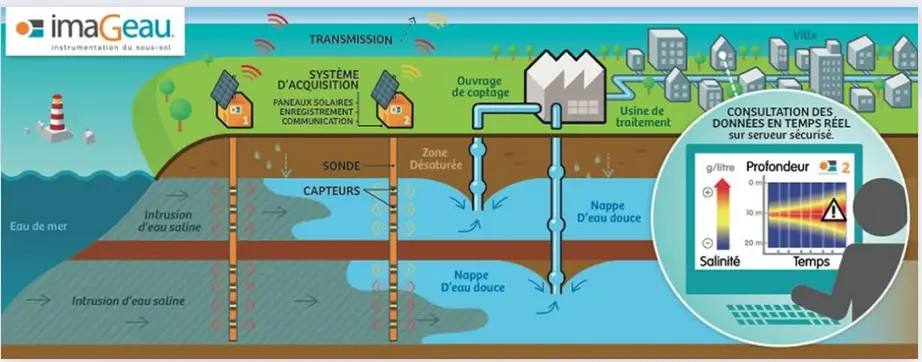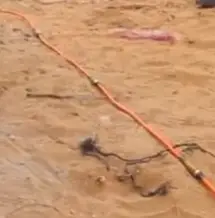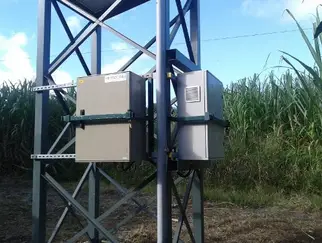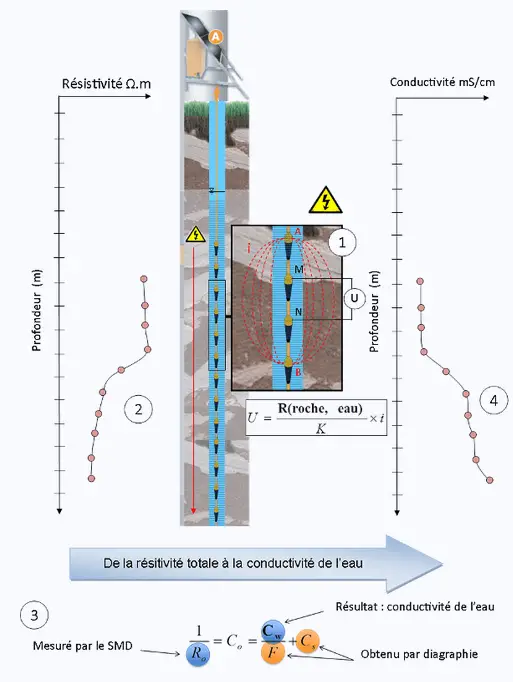SMD
groundwater monitoring tool for monitoring saline intrusions
SMD
Download the practice
People in charge of the innovative practice :
Denis NEYENS – denis.neyens@imageau.eu
SMD (subsurface monitoring device) is a tool for continuous monitoring of saline intrusions in groundwater. The practice was developed by imaGeau and is an integrated solution: from data collection on a water column to processing and analysis/interpretation via a specific platform. The objective of this practice is to instrument and collect data on the problem of saline intrusion.

Figure 1 : MAR/SAT system of Agon-Coutainville in France.
More precisely this practice allows to measure indirectly the salinity of the water on the whole height of the aquifer. The practice allows to have a logging (vertical profile), in an autonomous and repeated way, using a cable with positioned electrodes. On the surface, an autonomous acquisition box, powered by battery or solar panels and controlled by a computer equipped with a GPRS modem allows to send data files on imaGeau servers. The acquisition system also allows to inject an electric current between two electrodes and measure a potential difference.
The users of this innovative practice are local authorities, public organizations, research organizations (BRGM, DELTARES), and sometimes drinking water producers.
This practice has been developed in a context of salt water ridge and lack of knowledge of aquifer systems, to address the issues on quality and quantity of the water resource, and its impact on the economic sectors dependent on the exploitation of an aquifer system
Responsible entity
ImaGeau is a subsidiary of the SAUR group with a dual environmental and digital expertise. ImaGeau has been developing sensors, studies and a WEB application (EMI) since 2009, allowing the actors of the water cycle to implement sustainable practices of management and exploitation of the water resource.
The missions carried by imaGeau are:
- To put digital technology and artificial intelligence at the service of water resource preservation;
- Facilitate the understanding and sharing of issues related to water resources;
- Promote the adoption of water resource management and exploitation practices adapted to climate change;
- Reconcile the balance between environmental benefits, profitability and employee development.
Detailed explanation
The SMD consists of two distinct parts: (i) the electric flute, and (ii) the acquisition system.
The electric flute is the probe part in drilling. It is a chain of electrodes made of copper-aluminum, very resistant to corrosion, and which allows resistivity measurements. One or more pressure and temperature sensors are also integrated into the electrical cable installed in the piezometer.

The acquisition system is composed of:
- A low consumption computer on which a proprietary software manages the acquisition of measurements, the processes of the tasks, the remote communication (for sending files and remote control);
- Electronic cards for each electrode in wells;
- A power supply which also acts as a DC current injection source for electrical measurements.

The principle of measurement is as follows: The acquisition software manages the injection power supply and the electronic cards allowing to inject a known electric current between two electrodes (A and B) and to measure the potential difference induced between two other electrodes (M and N). Through Ohm’s law, the average resistivity is then measured around the piezometer between these 4 electrodes.

vertical of the piezometer allows to realize a profile of resistivity around the piezometer (2). Using the Waxman-Smits equation (3), the electrical conductivity of the water in the aquifer is then deduced. This requires knowledge of the formation factor (F) and surface conductivity (Cs) which are determined at the SMD facility using a reduced set of logs (gamma ray for clays, electrical resistivity and sonic P-wave velocity for porosity). Finally, a temperature-normalized, well-corrected electrical conductivity profile of the aquifer water around the piezometer is measured at repeated intervals (4).
Institutional setting
This practice is implemented within the framework of monitoring the qualitative and quantitative status of groundwater. The regulatory framework is then site-dependent.
Geographical setting
The practice is used on the scale of coastal aquifer systems, in France and internationally. The solution has already been deployed in France, Reunion Island, the Netherlands, Israel, Chile and Morocco (Chtoucka aquifer).
The practice is also used for certain continental aquifer systems in specific geological contexts, such as in Jordan where the salt water wedge originates from gypsum strata.
Historical overview
Most of the development of this solution was undertaken between 2010 and 2016 with the aim of improving the system and integrating other types of sensors. From 2016 to 2017, the solution moved into the industrialization phase, with the manufacturing of some elements under subcontract.
The key factors in implementing this practice are: (i) study sites with a lot of data available, and (ii) successive experiments that improved the reliability of the measurement and its credibility in order to move to the industrialization phase.
The obstacles encountered are that at the beginning of the development of the solution, it was not equipped with a platform for processing/analysis of the collected data, and therefore the data were often not used by the customers due to lack of skills.
On the other hand, imaGeau was confronted with a problem of acceptability of the innovation, it was necessary to convince the community of hydrogeologists on the reliability of the solution.
Finally, to make the solution viable for operators, it was necessary to transform the information provided by the data measured in-situ into volumes of water that could be used by water producers.
Evidence of benefits from implementation
The advantages of using this practice are: (i) the absence of electronics immersed in the borehole, (ii) limited maintenance, (iii) a system with a long service life, and (iv) a totally autonomous and remotely controllable system.
The other advantage of using this technique is that, the “well effect” is limited because the measurement is extended around the borehole (about 60 cm, depending on the spacing of the electrodes).
The results of various studies where this solution has been deployed have been published in international papers and conferences (SWIMM, IAH). The solution had also been the subject of a patent application.
Replication potential in SUDOE region
The practice has a strong production potential, as it can be deployed on any type of coastal aquifer system (or continental aquifer system with geological formations such as Gypses) subject to saltwater intrusion.
Two people work on part-time (dedicated time is depending on the type of project) on the development and maintenance of the practice. The mission now consists in testing the systems, installing them, monitoring them and carrying out maintenance either remotely or in the field.
Future outlook
A long-term outlook of the solution is the adaptation of the technology to different issues, such as using this technique to perform cross acquisition also called “tomography between wells” to monitor hydrocarbon pollution, landslide areas, CO2 storage areas, etc. Another perspective concerns the prediction of the risk of a salt-water wedge in the Mediterranean area, based on data collected by the solution, and the coupling of physical models and artificial intelligence models.
Key points of the innovative method
Monitoring of saline intrusions
- Can be use for coastal and continental aquifers
- Stand-alone, plug-and-play solution
- Data transmission and interface for data processing and analysis
Acknowledgements
The innovative practice was suggested by Olivier DEPRAZ (imaGeau) and Denis NEYENS (imaGeau) participated in the interview.
References
Bellot, J-P., Neyens, D., Pezard, P., Depraz, O., Barry, S., De Mezzo, B., Henry, G., Depraz, L., Baqué, L. (2012). A new downhole, real time and near field hydrogeophysical observatory of groundwater quality. Near Surface Geosciences – 18th European Meeting of Environmental and Engineering Geophysics Paris, France, 3-5 septembre 2012.
Baïsset, M., Neyens, D. (2018). High frequency saltwater intrusion monitoring using borehole geophysical tools (SMD). 25th salt water intrusion meeting, 17-22 june 2018, Gdansk, Poland.
Tal, A., Weinstein, Y., Baïsset, M., Golan, A., Yechieli, Y. (2019). High resolution monitoring of seawater intrusion in a multi-aquifer system-implementation of a new downhole geophysical tool. Water, 11, 1877, doi:10.3390/w11091877
INTERNET REFERENCES:
imaGeau : https://imageau.eu/
aquifer
news
Discover more on the Aquifer project news and on aquifer management
aquifer news
Description and objectives of the project
The scientific community recommends a substantial improvement in the knowledge of aquifers, the establishment of reliable monitoring networks and a greater involvement of the administration and users to achieve a sustainable management of aquifers. The main objective...
Information on the project
The Llobregat Delta Water Users' Community has designed recharge basins in Molins de Rei to recharge the Baix Llobregat aquifer. View of one of the reloading basins during the test phase The Llobregat Delta Water Users' Community is one of the nine partners in the...
Success stories in groundwater management
Compilation of groundwater management success stories completed. Throughout April, the 30 cases of innovative practices in groundwater management have already been selected by the clusters participating in the project: PPA, CWP and AV. The task started with the...
PROPOSE AN
INNOVATIVE PRACTICE
You are in charge of an innovative practice regarding aquifer management and you want to referenced it on the Aquifer platform ?
Fulfill the form and propose it to the Aquifer partners.
THE EBOOK
Aquifer offers a range of innovative water management practices. You can download all our fact sheets here.
e-book of innovative practices
DOCUMENTATION
To go further on information related to the management of aquifers